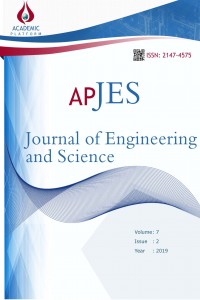Abstract
In this study, agloflotation experiments were conducted and fine (<500 µm) wastes from a coal washing plant operating in
Zonguldak were used. 33.75% ash wastes were mixed with soybean oil and agglomerated, then taken to a flotation cell and clean
coal/fuel was floated in this cell. The yield of the floating clean coal was 56.40% by weight and the content of ash was 14.80%.
The net calorific value was increased from 3620 to 5072 kcal / kg. In addition, tests were conducted with kerosene, a fossil fuel
and widely used in flotation, and the results were compared with those of soybean oil. Soybean oil as a collector showed about
20% lower performance than the kerosene in terms of efficiency and selectivity.
References
- [1] K. Bilir, “Kömür Flotasyonunda Kullanılan Gazyağı Miktarının Oranların Farkı Testi ile Optimizasyonu”, Eskişehir Osmangazi Üniversitesi Mühendislik Mimarlık Fakültesi Dergisi, 24, 1, 119-130, (2011).
- [2] H. Hacifazlioğlu and G.H. Gerdan, “Taşkömürü Tozları Flotasyonunda Sıcaklığın Etkisi”, Adıyaman Üniversitesi Mühendislik Bilimleri Dergisi, 5, 1-8, (2016).
- [3] S. Bhattacharya and R.D. Pascoe, “Effect of Temperature on Coal Flotation Performance - A Review, Mineral Processing & Extractive Metall. Rev., 26, 1, 31-61, (2005).
- [4] S.M. Bulatovic, 2007. Handbook of flotation reagents: chemistry, theory and practice: Volume 1: flotation of sulfide ores, Elsevier Science, Peterborough, Ontario, Canada, (2007).
- [5] S. Atak and R. Tolun, Cevher Hazırlama El Kitabı, Ed.G.Önal, G.Ateşok, K.T.Perek., YMGV, İstanbul, 185-236, (2014).
- [6] N. Vasumathi, T.V.J. Kumar, S.S. Rao, S. Parabhakar, G.B. Raju, S.S. Kumar and U. Raman, “Eco Friendly and Cost Effective reagent for coal flotation”, International Journal of Engineering Research, 2, 7, 418-423, (2013).
- [7] M.I. Alanso, C. Castano and B. Garcia, “Performance of vegetable oils as flotation collectors for the recovery of coal from coal fines wastes”, Coal Preparation, 21, 411-420, (2000).
- [8] A.F. Valdes and A.B. Garcia, “On the utilization of vaste wegetable oil (WVO) as agglomerants to recover coal from coal fines cleaning wastes (CFCW)”, Fuel, 85, 607-614, (2006).
- [9] G.H.V.C. Chary and M.G. Dastidar, “Comprehensive study of process parameters affecting oil agglomeration using vegetable oils”, Fuel, 106, 285–292, (2013).
Abstract
Bu çalışmada agloflotasyon deneyleri yapılmış ve Zonguldak’ta faaliyet gösteren bir kömür yıkama tesisinin ince (<500µm)
atıkları kullanılmıştır. %33.75 küllü atıklar soya yağı ile karıştırılıp aglomere edildikten sonra bir flotasyon hücresine alınmış ve
bu hücre içinde temiz kömür/yakıt yüzdürülerek ayrılmıştır. Yüzen temiz kömürlerin ağırlıkça verimi %56.40 olup, kül içeriği
%14.80 bulunmuştur. Net kalorifik değer 3620’den 5072 kcal/kg’a yükseltilmiştir. Ayrıca, fosil bir yakıt olan ve flotasyonda
yaygın olarak kullanılan gazyağı ile de testler yapılmış ve sonuçlar soya yağının sonuçları ile karşılaştırılmıştır. Bir kollektör
olarak soya yağı verimlilik ve seçimlilik yönünden gazyağına göre yaklaşık %20 daha düşük performans göstermiştir.
References
- [1] K. Bilir, “Kömür Flotasyonunda Kullanılan Gazyağı Miktarının Oranların Farkı Testi ile Optimizasyonu”, Eskişehir Osmangazi Üniversitesi Mühendislik Mimarlık Fakültesi Dergisi, 24, 1, 119-130, (2011).
- [2] H. Hacifazlioğlu and G.H. Gerdan, “Taşkömürü Tozları Flotasyonunda Sıcaklığın Etkisi”, Adıyaman Üniversitesi Mühendislik Bilimleri Dergisi, 5, 1-8, (2016).
- [3] S. Bhattacharya and R.D. Pascoe, “Effect of Temperature on Coal Flotation Performance - A Review, Mineral Processing & Extractive Metall. Rev., 26, 1, 31-61, (2005).
- [4] S.M. Bulatovic, 2007. Handbook of flotation reagents: chemistry, theory and practice: Volume 1: flotation of sulfide ores, Elsevier Science, Peterborough, Ontario, Canada, (2007).
- [5] S. Atak and R. Tolun, Cevher Hazırlama El Kitabı, Ed.G.Önal, G.Ateşok, K.T.Perek., YMGV, İstanbul, 185-236, (2014).
- [6] N. Vasumathi, T.V.J. Kumar, S.S. Rao, S. Parabhakar, G.B. Raju, S.S. Kumar and U. Raman, “Eco Friendly and Cost Effective reagent for coal flotation”, International Journal of Engineering Research, 2, 7, 418-423, (2013).
- [7] M.I. Alanso, C. Castano and B. Garcia, “Performance of vegetable oils as flotation collectors for the recovery of coal from coal fines wastes”, Coal Preparation, 21, 411-420, (2000).
- [8] A.F. Valdes and A.B. Garcia, “On the utilization of vaste wegetable oil (WVO) as agglomerants to recover coal from coal fines cleaning wastes (CFCW)”, Fuel, 85, 607-614, (2006).
- [9] G.H.V.C. Chary and M.G. Dastidar, “Comprehensive study of process parameters affecting oil agglomeration using vegetable oils”, Fuel, 106, 285–292, (2013).
Details
| Primary Language | Turkish |
|---|---|
| Subjects | Engineering |
| Journal Section | Articles |
| Authors | |
| Publication Date | May 25, 2019 |
| Submission Date | June 27, 2018 |
| Published in Issue | Year 2019 Volume: 7 Issue: 2 |


